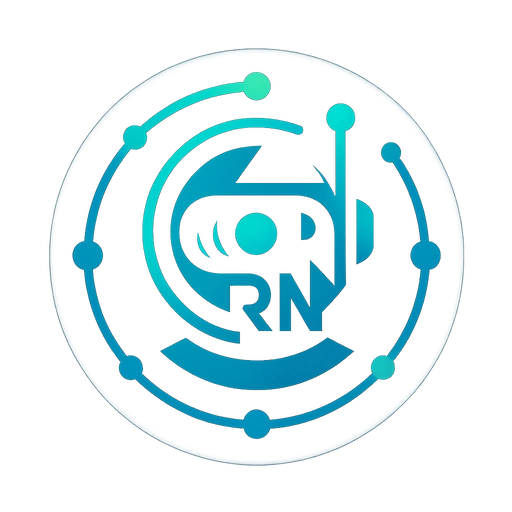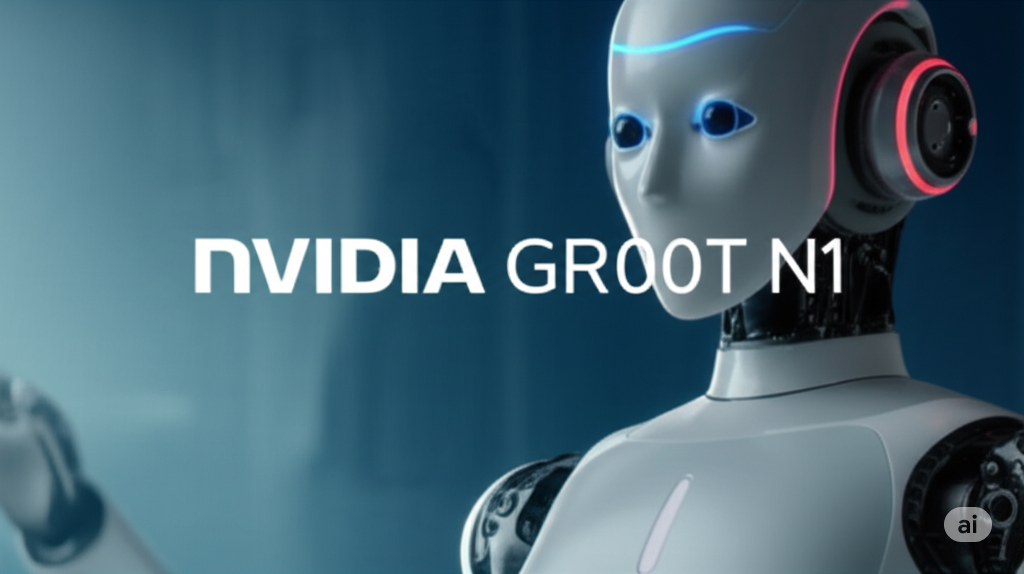Table of Contents
INTRODUCTION: HUMANOIDS ARE GETTING BRAINS
For decades, humanoid robots lived at the intersection of science fiction and laboratory curiosity. They could shuffle across trade show floors, wave at cameras, and occasionally pour a drink but they weren’t exactly teammates. That changed at NVIDIA’s GTC 2025 conference, when Jensen Huang walked on stage to announce Nvidia GR00T N1, the company’s first open foundation model for humanoid robots.
If GPUs gave AI its imagination, GR00T N1 is giving robots something far more tangible: a brain that can learn, adapt, and reason in the real world. From manufacturing floors to hospital corridors, Nvidia GR00T humanoid robots aren’t a “five years away” vision anymore. They’re arriving much faster.
2. WHAT IS NVIDIA PROJECT GR00T?
Nvidia Project GR00T (Generalist Robot 00 Technology) is the company’s bold attempt to give humanoid robots a general-purpose foundation model.GR00T stands for Generalist Robot 00 Technology, and N1 is its inaugural open foundation model. It blends perception, planning, and motion into a single pre-trained brain for humanoid robots Unlike older robots trained for narrow tasks, GR00T N1 enables robots to:
- Understand natural language commands
- Observe and imitate human actions
- Generalize across environments and tasks
At its core, the model is designed as a generalist robot foundation model. That means instead of training a new model from scratch every time a robot needs to pick up a wrench or fold laundry, GR00T provides a flexible “starter brain.” Developers can fine-tune it with real or synthetic data to specialize for their robot’s environment.
3. THINKING FAST AND SLOW: THE DUAL-SYSTEM ARCHITECTURE
Nvidia borrowed a page from cognitive science with GR00T’s dual-system architecture robotics. Inspired by Daniel Kahneman’s Thinking, Fast and Slow, the model has two complementary systems:
- System 2: Slow, Deliberate Reasoning
Handles language, vision, and high-level planning. For example, interpreting the command “Bring me a glass of water” and breaking it down into steps. - System 1: Fast, Reactive Control
Handles low-level motor skills, reflexes, and continuous adjustments. This ensures smooth, human-like motion while adapting to real-world conditions.
Together, they let humanoid robots combine reasoning with real-time agility a breakthrough in humanoid robot AI.No more one-trick robots. GR00T N1 handles grasping, handing items from one arm to another, long-context multi-step tasks. It’s a universal “thinking agent,” not a task automaton
4. THE POWER BEHIND THE BRAIN: NVIDIA ISAAC LAB AND OMNIVERSE
A foundation model is only as good as the training environment, and here’s where Nvidia Isaac Lab and Nvidia Omniverse simulation come in.NVIDIA can generate 750,000 synthetic trajectories in just 11 hours that’s equivalent to 6,500 hours of human demo
4.1 Isaac Lab
Isaac Lab is a robotics training playground where developers can test, fine-tune, and validate GR00T N1 behaviors before deploying to physical robots. It’s also where NVIDIA’s Isaac Manipulator and Isaac Perceptor toolkits live, supporting dexterous hand control and advanced perception.
4.2 Synthetic Data Generation
One of GR00T’s biggest advantages is synthetic data generation for robots. Training robots in the real world is slow, expensive, and sometimes unsafe. Using Omniverse, NVIDIA can create millions of simulated scenarios , from slippery floors to dim lighting , so robots can learn faster and safer.
4.3 Omniverse Blueprints
Developers can feed a handful of human demonstrations into Omniverse, then use GR00T Blueprints to generate thousands of variations. This approach means even startups without giant data labs can build competent humanoids. Together, these simulation pipelines power rapid iteration and make “train in reality” almost obsolete.
5. NVIDIA GR00T N1 IN ACTION
At GTC, Huang showed off robots from partners like 1X Technologies performing domestic tasks using policies trained on GR00T N1. Other demonstrations included Agility Robotics’ Digit carrying boxes, Boston Dynamics testing perception-driven mobility, and Apptronik humanoids learning manipulation tasks.
The results weren’t just demos. These companies are actively building humanoid robots with Nvidia GR00T N1 as their cognitive backbone.
6. WHO IS USING NVIDIA’S HUMANOID ROBOT AI?
Nvidia has assembled an impressive roster of partners:
- Figure AI – training their humanoid “Figure 01” with GR00T.
- 1X Technologies – deploying humanoid assistants like NEO Gamma.
- Agility Robotics – enhancing Digit’s warehouse skills.
- Apptronik – working on Apollo humanoid robots.
- Sanctuary AI – combining GR00T with cognitive architectures for versatile service robots.
- Boston Dynamics – integrating GR00T for research and industrial robots.
This ecosystem makes one thing clear: GR00T isn’t a toy project, it’s rapidly becoming the operating system for humanoid robots. At GTC, NVIDIA also revealed collaborations beyond the usual, with Google DeepMind and Disney Research to build Newton, a next-gen physics engine to train tactile, dexterous robots
7. NVIDIA’S BROADER ROBOTICS PLATFORM
Nvidia GR00T N1 is just one piece of a larger Nvidia robotics platform.

- Nvidia Jetson Thor – a robotics supercomputer-on-module designed to run foundation models like GR00T.
- Nvidia robotics lab – expanding R&D for embodied AI.
- Nvidia robot simulator – built on Isaac Lab, providing developers a way to rehearse scenarios before deploying.
- Nvidia robot kit – Jetson-based developer kits let startups experiment without building hardware from scratch.
- Nvidia robotics jobs – the company’s hiring spree signals that embodied AI is one of its biggest bets.
Together, these pieces form a cloud-to-robot pipeline: from simulation, to training, to deployment.
Nvidia GR00T vs. Tesla Optimus vs. Figure 02 vs. Boston Dynamics Atlas
“How Nvidia GR00T humanoid robots differ from Boston Dynamics robots”
The humanoid space is moving fast. Nvidia’s unique angle is platform + model + silicon rather than building a single branded robot. Below is a high-level snapshot based on public information and 2024–2025 reporting.
| Cons / Risks | Why it matters |
|---|---|
| Early-stage deployment | Many capabilities are emerging; real-world reliability and ROI must be proven at scale. NVIDIA Newsroom |
| Complex integration | Brownfield facilities vary widely; perception, grasping, and safety certification take time. (General industry reality; implied across sources.) |
| Data-domain gaps | Synthetic data helps, but bridging sim-to-real for contact-rich manipulation still demands careful tuning. NVIDIA Developer |
| Cost and power envelope | High-end sensors, actuators, and compute raise BOM and power considerations; business case must pencil. NVIDIA |
8. WHERE HUMANOID ROBOTS FIT IN
Humanoid robots powered by GR00T N1 aren’t just curiosities , they’re poised to enter real industries.
8.1 Manufacturing
The first major adopter. Robots trained in controlled environments like assembly lines will rapidly scale.
8.2 Logistics
Think warehouses where humanoid robot figures can handle mixed tasks that fixed automation can’t.
8.3 Healthcare
Assisting nurses, fetching supplies, even providing companionship.
8.4 Homes
This one’s further away, but the idea of a humanoid robot vs non humanoid robot at home is simple: a humanoid fits into spaces designed for humans, making it more versatile.
9. THE FUTURE OF HUMANOID ROBOTS WITH GENERALIST AI
The arrival of Nvidia GR00T humanoid robots signals a major shift. Robots won’t be defined by their hardware alone but by their ability to adapt, generalize, and improve.
As Huang put it, the question isn’t whether humanoid robots will arrive, but how fast. With GR00T, synthetic data, and an ecosystem of partners, the timeline looks shorter than anyone expected. NVidia GR00T N1 flips the script: humanoid robots can be adaptable companions, not fixed-paneled machinery. Think manufacturing, logistics, hospitality—even home help. With open tools and broad early adoption, this could shape robotics for years to come.
10. CONCLUSION: A GENERALIST BRAIN FOR ROBOTS
Nvidia GR00T N1 is more than a research milestone. It’s a turning point for robotics. By combining foundation models, synthetic data, and dual-system architecture, NVIDIA has created the blueprint for adaptable humanoid robots.No more stilted movements. No more task-by-task models. NVIDIA’s GR00T N1 gives robots a real brain, one that sees, thinks, and acts with generalist flexibility. It’s a technical shift and an open-source invitation to build something smarter, faster.
So, ready to make your robot learn to clean, navigate, or fetch your coffee mug? The tools are laid out—grab them, post-train your own GR00T, and let humanoids help out, wherever you need them.
If you’re a dev curious to get started or a leader plotting robotics strategy, now’s your moment. Let’s build the future, one GR00T-powered robot at a time.
The future isn’t about asking if robots can help us — it’s about deciding where to put them first.
Call to Action: If you’re a developer, grab the Nvidia GR00T N1 model on Hugging Face and explore Isaac Lab. If you’re a business leader, it’s time to plan how Nvidia GR00T humanoid robots can solve your workforce and logistics challenges. Head over to NVIDIA’s Developer site, grab the GR00T N1 model on Hugging Face, spin up Isaac Sim, and start teaching your bot something new today.
FREQUENTLY ASKED QUESTIONS:
- What exactly is Nvidia’s Project GR00T?
GR00T is a generalist robot foundation model that allows humanoid robots to understand language, learn new skills by watching humans, and perform a wide range of actions.
- Q2. How does the GR00T N1 “thinking fast and slow” architecture work?
It combines two systems. System 2 interprets complex commands and plans tasks. System 1 handles reflexes and motor control, ensuring smooth, real-time execution.
- Q3. Which companies are already using or partnering on Nvidia GR00T N1
Nvidia’s partners include Boston Dynamics, Figure AI, Agility Robotics, Apptronik, Sanctuary AI, and 1X Technologies
- Q4. Why is synthetic data generation so important for Nvidia GR00T N1 ?
Training in real life is slow and risky. Nvidia Omniverse simulation creates millions of safe, realistic scenarios. This accelerates learning and prepares robots for diverse environments.
- Q5. What does Nvidia GR00T N1 mean for the future of humanoid robots?
It shifts robots from single-task tools to general-purpose assistants. Expect deployments in manufacturing, logistics, healthcare, and eventually, in homes


